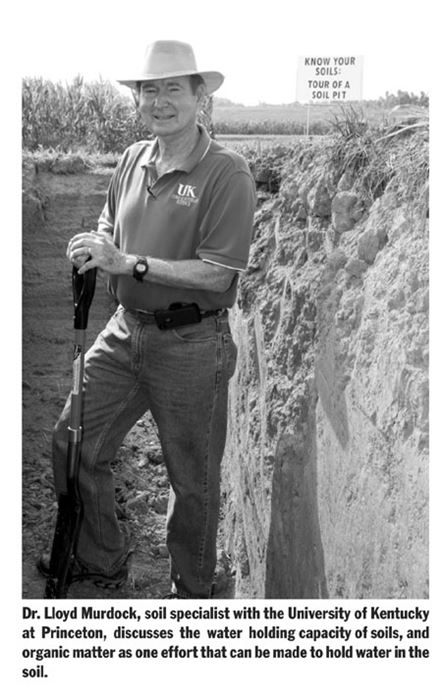Organic Matter Boosts Water Holding Capacity
PRINCETON, KY.
Residue on the soil surface is one method to
conserve water in a drought situation like
this year, according to Dr. Lloyd Murdock,
soil specialist with the University of Kentucky
at Princeton. In a discussion on the water holding
capacity of soils, he pointed to organic matter
as one effort that can be made to hold water
in the soil.
“A lot of our soils in Kentucky aren’t deep
enough to hold all the water that we will need
for a corn crop, even with regular rainfall events
that we have on a normal basis,” he said. “We’re
actually limited almost every year with water
and then on these particular years when it’s
very, very dry we’re extremely limited because
the soil is just too shallow. We have silt loam
soils which is really good, it’s the best you can
have on the surface, but the shallow depth is
what limits us.”
He discussed some things that farmers can do
to improve that. No one can change the soil but
it can be improved.
“We don’t have a lot of sources of water for irrigation
in Kentucky but we do have some, so
it’s imperative that if a person has a chance to
put in an irrigation system in Kentucky it’s obvious
that we should be looking and thinking in
those terms,” he said. “In a lot of places we don’t
have that opportunity.”

In those cases, farmers need to try to keep as
much water as possible on the soil, get it into
the soil and hold it.
“Basically that boils down to organic matter
and leaving residue on the soil surface,” Murdock
said. “The more residue that we produce
and leave on the soil surface the better the decomposition,
the better structure that occurs on
topsoil and so consequently we get better water
relationships and better water holding capacity.
“That’s basically what we need to do in our soils,
especially our shallower soils in the state of
Kentucky.” Δ
BETTY VALLE GEGG-NAEGER: Senior Staff
Writer, MidAmerica Farmer Grower